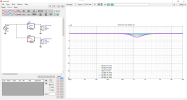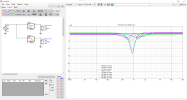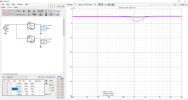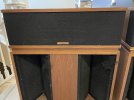My understanding is that, in order to effectively avoid the mouth reflection in an axisymmetric device, a great deal of real estate has to be devoted to the round-over, and it has to be a full round-over, like the Le Cleac'h horns. Obviously it can be done at the expense of increased driver spacing and/or reduced effective mouth diameter, so imo it's a tradeoff.
Hi,
you are right the roundover needs real estate just like roundovers for any transducer if you want to address effects of diffraction. Also direct radiating tweeter on a flat baffle would benefit roundovers and it's not technology related but wavelength related how big of a roundover is needed. Basically all physical objects are waveguides in this sense, sound interacts with physical objects the same regardless how it is named, only the shape matters in this regard. I find all these comparisons irrelevant in sense that they might not be sound based but technology based, like domes vs horns, because both are just implementation of high frequency part of a loudspeaker and can be implemented better or worse, and are suitable better or worse to any particular application.
A tweeter and a woofer cannot get into 1/4 wavelength c-c spacing if one cares about directivity, so if c-c is an issue then MEH is the obvious solution, for which one can also use good waveguide profile. As c-c is greater than 1wl additional sidelobes are introduced around crossover frequency, and nulls get closer to listening axis the greater the c-c. But, ERDI gets better actually, CTA2024 data gets better with increased c-c and LR xo. As the nulls get closer to listening axis it might be audible issue, depends on your system application whether your ear ever enter such null. For example +-20cm elevation difference from listening axis with 2m listening distance is about 6deg, and one might notice dip in frequency response. The further one listens the more early reflections affect and the harder it is to notice. So, like always it's play of trade-offs so it's just matter of choosing which ones are more important for the project at hand.
edit.
quick example, lets get important vertical angles. In 250cm tall room, 90cm listening height (sitting) at 2m listening distance, off-axis angles toward early specular reflections are roughly -40deg toward floor and 60deg toward ceiling. If listening distance is longer, these angles drop and are rouhgly -30deg and 50deg. If the person stood up he'd listen about at 20deg off-axis with the 2m listening distance and about 15deg when at 3m. +-10deg angles give some hint how much sound changes if head is not exactly at listening axis height. 10deg is about 35cm at 2m and about 50cm at 3m so various height people sitting at listening chair are likely much less than 10deg off-axis vertically.
Here different wavelength c-c spacing using two ideal transducers and ideal LR4 xo showing the listed important vertical off-axis angles. Listening axis is always exactly midway between the two sources in these examples so always flat. The other lines show what the response is toward the other important vertical angles. Obviously 1/4wl spacing gives most similar response to all directions, but since it's usually physically impossible ~0.75wl is about best we can do unless it is a coaxial/MEH.






On a quick look even the huge 1.5wl spacing looks just fine among the possible options, which is great relief for speaker designer because it means in some projects waveguide can fit big roundovers comfortably. If one wants to optimize some particular angle, then look closer for some particular c-c. The big c-c make CTA2034 DI and ERDI graphs look better so increases also the preference score sometimes used in this forum. What is better choise then clearly depends a lot of room acoustics, listening distance and height, how fixed the listening position, whether it's background or critical listening and so on.
edit. oops, the above are missing +20deg angle, when one is standing ~2m away from speakers. So here another set just with 10 and 20deg off-axis, which represent various typical direct sound vertical listening angles.





I'm reading from the graphs that regardless of c-c one should elevate the system to ear height to avoid dip around crossover. In general, dips are quite hard to perceive though, so personally I look the DI curves and don't mind about these particular angles but the average. My system has 1.2wl spacing and it is not obvious there is a dip around crossover when moving around the room, sitting standing and so on. If I get closer to speakers and search for it specifically, it's audible.
My understanding is that Marcel's software is intended for the DIY community and I'm not a DIYer. But I'm not convinced there is significant improvement to be made over the Oblate Spheroid profile, assuming constant directivity with minimal disturbance of the wavefront is the priority.
The whole thing started from OS profile and the fact that it's infinite and doesn't provide termination to baffle / freestanding, which easily leads to abrupt curvature change and diffraction. Marcel came up with math equation that is easy to tune so that computer simulation can be used to find good mouth termination for OS throat. See his papers on the at-horns.eu frontpage,
first paper starts explaining this. If you start playing with the ATH profiles and simulating this stuff it's soon apparent all that matters is the curve, not the name of the curve, so in the end nothing else matters than the results. After all, it costs about the same to manufacture better or worse profile waveguide so why not try to squeeze best out of it. Traditionally it was very hard if not impossible to come up with good waveguide and difficult to manufacture it, now both are relatively trivial tasks.
I have not been favorably impressed with 3D printed horns thus far, but am waiting on a quote from a company who uses a technique that's significantly more advanced than desktop printing.
Yeah desktop printing is the easiest and cheapest way to get hold into this stuff, available for anyone anywhere in the world. One could do mold for casting or manufacture the device from wood in a lathe, CNC or anything, build it just like any other device is built.
Bottom line is that anything is possible today, within limits of physics of course

So, the main problem with speakers is not the devices but the plan, to understand which kind of device aligns with requirements of the project. The devices, like drivers and waveguides are kind of irrelevant, as long as there is a plan there is likely the most suitable device available.
Phew, sorry for very long post and that I included the examples making it more general response than just a reply to yours.
In retrospect I was triggered a bit about the posts on this thread in general and I kind of described here how I see this stuff and that I'd gladly use freestanding waveguide with roundover and not think this c-c thing as a bad trade-off. Performance from mabat waveguides are so good I have no lust for anything else, I just roll my own as I see fit. Could do it for a dome tweeter if I wanted to use one. This is not attempt to push this stuff to anyone, just one perspective to things that was missing from the thread. So, if anyone hears a bad sounding horn system, it might not be fault of the horn but multiple things, while could be the horn as well. If it's the horn, just make a better one, it's trivial

ps. I shouldn't do posts like this, takes a lot of energy and perhaps not very useful to anyone.














